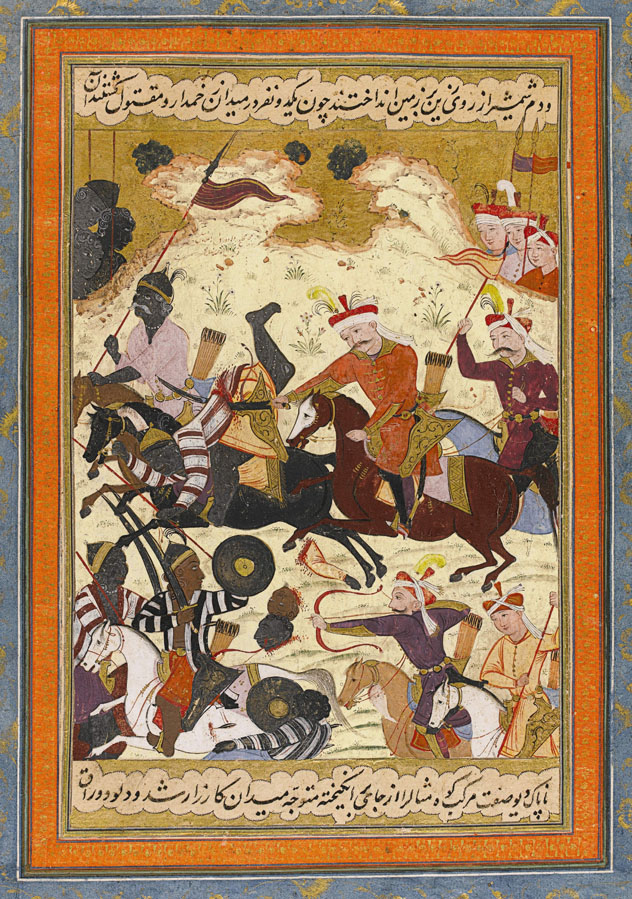Morād Beg Kills the Ethiopian Slave
Location: Current whereabouts unknown
Mount: Light blue-gray mount with gold decoration 35.8 x 23.5 cm; orange collar.
Written surface: 23.6 x 15.3 cm. (estimated)
Painting: 19.6 x 15.3 cm. (estimated)
Text references: J.K., p.483 lines 9 to 12.
See Muntaẓer-Ṣāḥeb_1970, pp.160-64 for this event in the History of Shah Esmāʿil.
Date of this event: 920/ Spring 1514
The text relates the following. The accomplishments of Shah Esmāʿil were well known in the Arab lands. One day, the Mamluk ruler of Egypt, Sultan Ǧānisāy Ḵādem al-Haramin, gave a celebration attended by an Ethiopian slave named Saʿadān Ǧolom-e Ḥabashi Solṭān, also known as Żujondin. This Ethiopian was well respected for his combat ability, and boasted that he could even defeat Esmāʿil in combat. A ǧāzi from Iran was also present chastised Saʿadān for not following the proper rules of conduct; if Saʿadān felt himself a noble warrior, the ǧāzi taunted, he should challenge a person of equal station such as Khan Moḥammad Ǩān (Khan Moḥammad ʿOstājlu, the Safavid governor of Diār Bakr). Saʿadān became angered and asked Sultan Ǧānisāy for permission to go and bring Khan Moḥammad back to Egypt. Permission granted, Saʿadān departed with 300 men for Ḥamid. It was by coincidence that the dāruǧa of the molāzem of Khan Moḥammad with 70 men had arrived at the castle of Orfa to meet Sultan Qājār (Eje Sultan Qājār, the governor of Orfa). The dāruǧa and his men were admiring the spring scenery, when suddenly they came upon the 300 black men. A messenger from Saʿadān soon explained their mission to the dāruǧa, who replied: “It is indeed a coincidence that you, Saʿadān, should arrive before me. I am also a slave,... of Khan Moḥammad,... and having heard of you had asked to go to Egypt to confront you. What luck I will not have to travel all that way. But now that I am with only 70 men and you have 300, it is best that we not now fight together, but rather you should proceed on to the fort at Ḥamid and confront Moḥammad Ḵān.” The messenger related the words of the dāruǧa to Saʿadān, whereupon the Ethiopian became very proud, and advanced on the outnumbered Safavids. There was some skirmishing, and then Saʿadān moved toward the middle of the field of combat. The dāruǧa went after him. First they exchanged words, then parries, and finally the dāruǧa, screaming the name Mortazā ʿAli, cut the zangi’s pride separate from his body with the edge of his sword. The other ǧāzis then joined in the battle. Many Ethiopians were killed, twenty were captured, and the remainder fled.
In manuscript L (which is an earlier version of the jahāngushā'i-ye ḵāqān-e ṣāḥibibqirān) this painting follows by 10 folios the defeat of Abuʾl Ḵeyr Ḵān (ms.L, folio 232) which allegedly took place in 919/1513, and precedes by five folios the Battle of Čālderān (ms.L, folio 247v) of Rajab 920/November 1514. Since the text mentions twice that the event took place in the spring, it clearly can only be the spring of 920/1514. However, another variant of this painting also by Moʿin from the tāriḵ-e ʿālām-ārā-ye šāh esmāʿil, (cf. ms. M, folio 114v), suggests quite a different date for the event. In that manuscript the painting is located between the death of Sāru Qaplan in 913/1507-8, and Bābur’s encounter with Šāhibeg Ḵān (d. 915/1510). Another discrepency between the two texts can be found in the identification of the individual responsible for the death of Saʿadān. The text of manuscript L states him to be the dāruǧa (governor or police chief) of the molāzem (aide-de-camp) of Khan Moḥammad, but does not give his name. Manuscript M gives his name as Morād Beg, and his title as molāzem of Khan Moḥammad.
The painting illustrates the two main adversaries near the center of the composition. Morād Beg, astride a brown horse, lunges forward with his sword to slice up his opponent. Saʿadān, and the other Ethiopians are portrayed as dark-skinned humans properly clothed with striped tunics and pointed helmuts - a less stereotyped portrayal than the aborigines wearing loin cloths and armed with crude weapons in the earlier ms. L, f.242. Altogether only six ǧāzis represent the Safavid forces, of which only three participate in the onslaught on the battlefield, while three others appear content to observe the event from behind a ridge in the upper right. The Ethiopians, also six in number, are all on the left side. Armed with shields, swords, and and bows, flee before the Safavid onslaught. The setting is a barren sloping hillside that rises to a craggy ridge with only a suggestion of foliage. The painting has no inscriptions.
Painting references:
Christies London, 14 April 2010, Lot 78.
Photo courtesy of Christie's. ©Christie's Images Ltd. 2012
Robert Eng
Last Updated: August 18, 2011 | Originally published: August 1, 2011
